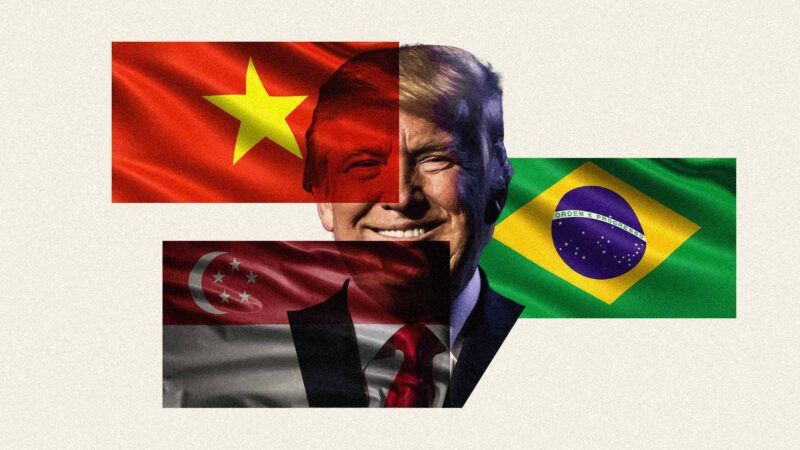Trump's New Tariffs on These 3 Countries Look Particularly Foolish
What tariffs on Singapore, Brazil, and Vietnam can tell us about how Trump misunderstands the value of trade.

Many things about the Trump administration's new global tariffs make little sense.
Those tariffs are a huge tax increase on American consumers and businesses—one that will raise taxes by $1.8 trillion and lower incomes by over 2 percent, according to the Tax Foundation's analysis. The White House seems to have used some fuzzy math in calculating those tariff rates. Trump is also, somehow, putting tariffs on countries inhabited solely by penguins—which has, in fairness, spurred robust growth in the manufacturing of memes. It is all very silly and largely self-destructive.
Yet, even by those standards, some of these new tariffs are truly outlandish. In the interest of narrowing down the chaos into a few bite-sized morsels, here are the three country-specific tariffs that make the least sense, based on what Trump himself has said are the guiding principles behind his new trade policies.
Singapore
For weeks, the White House has been using the word reciprocal to describe these new tariffs. "They charge us, we charge them," is how Trump described the tariffs on Wednesday.
If that's true, then the U.S. should be lowering its trade barriers with Singapore, which charges zero tariffs on most U.S. imports. (Indeed, Singapore's very existence is proof of the power of free trade. It has become one of the world's wealthiest nations not because it built a ton of factories or engaged in a lot of protectionist policies but by embracing low tariffs and free trade.)
Instead, Trump is slapping a 10 percent tariff on imports from Singapore. So much for "reciprocity."
You could say the same thing about Israel, which earlier this week decided to eliminate all tariffs on American imports in advance of Trump's tariff announcement. Did Trump respond to that move by lowering all American tariffs on imports from Israel? He did not: Israeli goods are now subject to a 17 percent tariff, per the list published Wednesday by the White House.
Brazil
Trump has repeatedly made the argument that higher tariffs are necessary to eliminate America's trade deficits with foreign countries. A trade deficit is the gap between the value of everything America imports from another country and the value of all goods exported to that same country.
But if that's the goal, then why are there new tariffs on goods imported from Brazil?
America runs a trade surplus with Brazil. Last year, that trade surplus totaled $7.4 billion, and that was a 32 percent increase from 2023, according to the U.S. Trade Representative.
For that matter, America also runs trade surpluses with Australia, Hong Kong, the Netherlands, Singapore, and the United Kingdom—and Trump just hiked tariffs on imports from all of those places too.
So, we can safely conclude that Trump's goal with these tariffs is not the elimination of America's trade deficits. Perhaps more accurately, we can conclude that the White House has prioritized higher tariffs for the sake of higher tariffs and is misleading the public by promising that higher tariffs are meant to reduce trade deficits.
Vietnam
Back in the halcyon days of 2018, when Trump's trade war was focused mostly on China, one of the clear goals was forcing manufacturers to relocate out of that country. Some moved to Vietnam—accelerating a trend that was already underway, as China moved up the so-called "value chain" and lower-level manufacturing shifted to other places.
Imports into the U.S. from Vietnam doubled between 2018 and 2023, while U.S. imports from China were declining.
Trump regarded that shift as proof that his tariffs were successful. "Many tariffed companies will be leaving China for Vietnam and other such countries in Asia," Trump claimed in May 2019, about a year after his tariffs were first imposed. "Thousands of companies are leaving because of the Tariffs."
So what happened on Wednesday? Trump slapped a staggering 46 percent tariff on all goods from Vietnam. As CNBC notes, those new tariffs will hit a ton of clothing and footwear brands, including Nike, Adidas, Hoka, Timberland, Vans, Steve Madden, and more. It will also raise prices for toys and household goods.
Imagine that you're running a company that relocated its supply chains out of China in the years since 2018. You tried to do what the Trump administration wanted. It didn't matter, and now you have to find yet another place to set up shop—or pass along a huge price increase to your customers.
That's the truly mind-boggling thing about the tariffs that Trump announced this week: They seem to undermine some of the very goals that Trump has claimed he wants to achieve. This isn't about reciprocity or lowering trade deficits or encouraging businesses to move supply chains away from potential adversaries. It is just pointlessly, mindlessly destructive.
Show Comments (37)